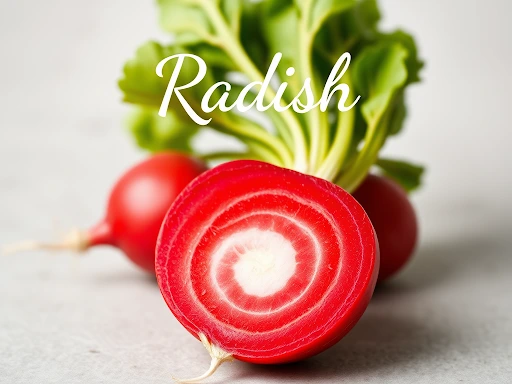Raddish: Its Cultural, Economic, and Scientific Significance
The raddish is renowned as a simple root vegetable, but it has contributed to different life aspects such as culture, economy, and scientific research. Ranging from ancient folklore to contemporary biotechnology, raddishes have been attributed for their symbolic essence, economic value, and health advantages. The following article examines the raddish’s role in folklore, its economic significance, its relation with gut health, the plethora of its varieties, and its prospects in agricultural research.
Raddish in Folklore, Myths, and Cultural Traditions
Ancient Beliefs and Symbolism of Raddish
Culturally, raddishes represent something much deeper in symbolism beyond just food. During the ancient Egyptian period, raddishes were thought to possess the magical ability to bring strength and were gulped down by the laborers that lifted the pyramids. The Romans and the Greeks were known to think raddishes brought prosperity, to the extent of gifting them to their gods. Some Asian cultures use raddishes as unique symbols that invite luck and prosperity during New Year festivities.
Raddish in Traditional Celebrations and Festivals.
Oaxaca, Mexico is known for celebrating an intricate festival of La Noche de Rabanos (The Night of Raddishes) on the 23rd of December every year. Citizens carve raddishes into mini sculptures illustrating their religious debates along with their historical and cultural events. Likewise, in Japan, raddishes feature in the Seven Herbs Festival where traditional soups are served as a wishing ceremony for good health and long life in the new year.
Mythological References to Raddish in Different Cultures.
Several myths and legends from around the world feature mention of raddishes. European folklore featured raddishes as a gift from fairies during the holiday season which supposedly protected against evil spirits. In ancient China, radidshes were viewed as a means of immortality, as it was believed consuming them extended ones life. In Slavic culture, it was a tradition to plant raddishes close to houses so they could ward off bad luck.
Superstitions and Folk Remedies Involving Raddish
Throughout history, radishes have been a prominent ingredient of folk medicine. European raddish remedies claim that consumption of the juices healed respiratory illness and was a remedy for cough. Several Asian cultures thought that radishes were beneficial to one’s health and guarded against illnesses along with fevers. Aside from the beliefs, some farmers also planted radishes along the borders of their fields in the hopes that they would ward off harmful pests while making the soil more fertile.
How Radish Has Influenced Art, Literature, And Storytelling
Radishes have always been a part of artwork and literature. Ancient manuscripts list raddishes as diet staples for soldiers and travelers. Market scenes in Renaissance paintings often included radishes as symbols of abundance. Children’s literature radishes are often used in fables and stories as symbols of simplicity and sustenance.
The Economic Importance of Radish Farming
Global Production and Trade of Radish
China, Japan, South Korea, India, and the United States are the leading producers of radishes, which are cultivated globally. The market for radishes has increased due to demand for fresh and processed forms of radishes. Exports of radish have increased to areas that are in need for specialty varieties of radishes.
How Radish Farming Supports Small Scale Farmers
Radish farming assists small scale farming. Radishes take only a short time to mature, which makes them ideal for farmers with small plots of land. They are important crops for many rural farmers and are sold in local markets.
The Organic and Specialty Market Demand for Radish
The consumption of organically grown radishes has drastically gone up with rising health awareness among consumers. Rare and special radish varieties like black or watermelon radishes are in demand, especially in specialty stores, and are popular among chefs and food lovers.
Radish as a Profitable Crop for Sustainable Agriculture
Its radish season, which means eco-friendly farming is back on the table! Unlike other crops that damage the soil, radishes actually improve its health by preventing soil erosion and breaking up compacted soil. Even better, they can be farmed with little to no pesticides.
Innovations in Radish Farming and Commercial Processing
With the new techniques in hydroponics farming, radishes can now be grown in controlled environments, resulting in higher yields and better quality. Furthermore, the introduction of vacuum sealed radish snacks and fermented radish snacks has added to the market value of this vegetable.
How Radish Contributes to Gut Health
The Role of Fiber in Radish for Digestion
Radishes contain a great amount of dietary fibers. As we all know, fiber is great for bowel movement, preventing constipation, and overall gut health.
Prebiotic Effects of Radish and Their Influence on Gut Microbiology
Radishes include prebiotics which help sustain the aforementioned beneficial microorganisms in the gut. This is helpful in maintaining a healthy microbiome which is important in digestion and immunity.
The Role of Radish in Alleviating Bloating and Other Gastrointestinal Disturbances
Radishes have some natural constituents that may assist digestive processes and reduce bloating. Their diuretic action may be mild in nature but these are beneficial in treating excessive fluid retention which is often the source of stomach discomfort.
Probiotic Effects of Fermented Radishes
“According to Idealoom, fermented dishes of radishes like kimchi and pickled radish contain probiotics that are essential for gut health. These aid in effective digestion, enhance the immune system, and support the absorption of nutrients owing to their probiotic effects.”
The Effect of Gut Health on General Immunity
Immunology of the intestines is associated with the health of the body and the stronger the gut the better and radishes indeed help to mediate this. The oxidative and vitamin constituents of radishes have protective qualities against infectious and inflammatory diseases.
Understanding the Color and Shape Diversity of Radishes
The Importance of Varietal Red, White, Purple and Black Radish Roots.
Different varieties of radish have different taste and nutritional values. For Example, red salad radish is most widely used in salads, while black radish is well known because of its strong sharp taste and medical effects.
How flavor and nutritional content are related to the color of the radish
Dark radishes are known to taste phyisically stronger than their lighter counterpart radishes which are comparatively sweeter in taste. This is often relates to how intense the flavor of the various radish types is.
The round cherry belle radish is often utilized in fresh salads while the daikon radish is frequently consumed in the pickled form or cooked. The cherry belle radish is more common in raw dished unlike the daikon which is elongated.
One of the largest radish in the world is sakurijima and the spanish black radish is also considered rare due to its known medicinal uses. These radishes are unique and with little availability making them stand out from the rest.
Gourmet chefs actively utilize radishes as they are aesthetically pleasing to the garnished dishes as well as add a unique taste which puts them on a higher pedestal as compared to other ingredients.
How to improve radish yield and disease resistance through genetic modification
Research is being conducted towards enhancing the sustainability for the production of radishes and achieving better productivity through modified varieties that are more resilient to disease or pests.
To understand the development of roots, radish is the primary plant used for research since they have the unique feature of growing their roots in a very short amount of time which is beneficial for scientists trying to learn about plant development.
Possible Medicinal Uses of Radish Extracts
The extracts of radishes have been researched for their inflammatory and antibacterial activity, which may give rise to new medicinal uses.
Medicinal Uses of Radish Extracts
The extracts obtained from radishes are studied for their anti-inflammatory functions and antimicrobial activity which may give rise to new medicinal uses.
Climate change and its effect on the cultivation of radish
As climatic conditions are changing, scientists are looking for cultivars of radish that can tolerate condenaryuppotclimate conditions to ensure food availability in the future.
The Role Technology Plays in the Futures of Farming Radishes
Improvements in precision farming, vertical agriculture, and automated audiovisual supervision are enhancing the effectiveness and environmental friendliness of radish production.
Final thoughts
These vegetables have been and will remain important in all aspects of human life. Their extensive cultivation is deeply rooted in elementary health values, mythical assumptions, and perspectives of innovations, radishes are undoubtedly one of the most sought after crops globally. Bearing in mind the ever-increasing need for healthy, ecologically-friendly food and diversification, the humble radished also serves as a reminder of traditions and the possibilities for advancement.
Read also: Cultural and Industrial Importance of Raddish in Medicine, Agriculture, and Cooking



